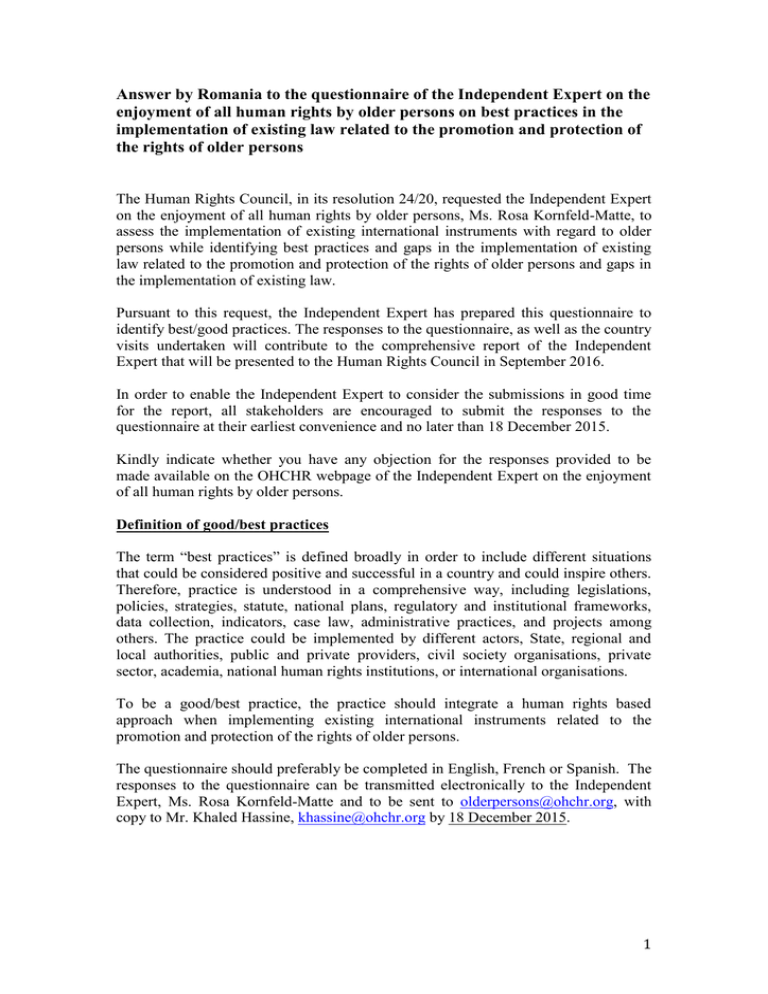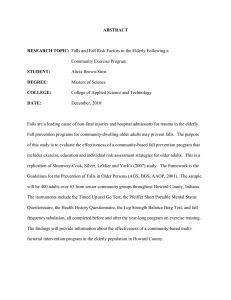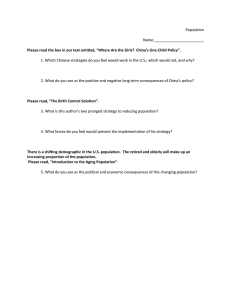Answer by Romania to the questionnaire of the Independent Expert... enjoyment of all human rights by older persons on best...
advertisement

Answer by Romania to the questionnaire of the Independent Expert on the enjoyment of all human rights by older persons on best practices in the implementation of existing law related to the promotion and protection of the rights of older persons The Human Rights Council, in its resolution 24/20, requested the Independent Expert on the enjoyment of all human rights by older persons, Ms. Rosa Kornfeld-Matte, to assess the implementation of existing international instruments with regard to older persons while identifying best practices and gaps in the implementation of existing law related to the promotion and protection of the rights of older persons and gaps in the implementation of existing law. Pursuant to this request, the Independent Expert has prepared this questionnaire to identify best/good practices. The responses to the questionnaire, as well as the country visits undertaken will contribute to the comprehensive report of the Independent Expert that will be presented to the Human Rights Council in September 2016. In order to enable the Independent Expert to consider the submissions in good time for the report, all stakeholders are encouraged to submit the responses to the questionnaire at their earliest convenience and no later than 18 December 2015. Kindly indicate whether you have any objection for the responses provided to be made available on the OHCHR webpage of the Independent Expert on the enjoyment of all human rights by older persons. Definition of good/best practices The term “best practices” is defined broadly in order to include different situations that could be considered positive and successful in a country and could inspire others. Therefore, practice is understood in a comprehensive way, including legislations, policies, strategies, statute, national plans, regulatory and institutional frameworks, data collection, indicators, case law, administrative practices, and projects among others. The practice could be implemented by different actors, State, regional and local authorities, public and private providers, civil society organisations, private sector, academia, national human rights institutions, or international organisations. To be a good/best practice, the practice should integrate a human rights based approach when implementing existing international instruments related to the promotion and protection of the rights of older persons. The questionnaire should preferably be completed in English, French or Spanish. The responses to the questionnaire can be transmitted electronically to the Independent Expert, Ms. Rosa Kornfeld-Matte and to be sent to olderpersons@ohchr.org, with copy to Mr. Khaled Hassine, khassine@ohchr.org by 18 December 2015. 1 Please include in your submissions the name of the State/organization submitting the practice, as well as contact details. Feel free to attach additional pages if you have several good/best practices to share. Your contact details: Name: Rusandu Olivia State/ Organisation: Social Services Directorate of the Ministry of Labour, Family, Social Protection and Elderly, Romania Email: olivia.rusandu@mmuncii.ro Telephone: +40745438074 Webpage: www.mmuncii.ro The Independent Expert would like to thank you for your support! For more information on the mandate of the Independent Expert, please visit: http://www.ohchr.org/EN/Issues/OlderPersons/IE/Pages/IEOlderPersons.aspx 2 Questionnaire of the Independent Expert on the enjoyment of all human rights by older persons on best practices in the implementation of existing law related to the promotion and protection of the rights of older persons 1. Name of the practice: National Strategy for the Promotion of Active Aging and the Protection of Elderly’s Rights 2015-2020 2. Area concerned: Discrimination (e.g. legal/institutional framework, access to facilities and services, etc.) Violence and abuse Adequate standard of living (e.g. resource availability, housing, etc.) Independence and autonomy (e.g. legal guardianship, accessibility, etc.) Participation Social protection (e.g. social security, incl. pension) Education, training and lifelong learning Care (home, family or institutional care, long-term care, palliative care, geriatric services, quality of care and availability of services, care workers, etc.) 3. Type of practice: Legal (Constitution, law, etc.) Policy/Programme/Strategy/Action Plan on Ageing Institution Regulation Administrative practice Case law/jurisprudence Disaggregated statistical data by age/gender Training programme Other (please specify):.................................... 4. Level of implementation: National Local (Sub-national, community, urban/rural area) Other (please specify):.................................... 5. Please describe the practice, including a) its purpose; b) when and how it was adopted; c) how long it has been used/implemented; and d) its geographic scope. The National Strategy and its corresponding Strategic Action Plan for the period 2015-2020 was also an ex-ante conditionality for accessing EU funds in the programming period 2014-2020. The Ministry of Labour, Family, Social Protection and Elderly (MoLFSPE) has initiated this strategy and currently the ministry is in the process of finalizing the Implementation Short Term Plan for the period 2016-2017. a) its purpose: 3 To create a society where elderly are encouraged and have the possibility to live a healthier, more productive, participative and independent life. Thus, through its policies, the strategy sets the goal of slowing down and reducing premature physical aging, and, where it is possible, to encourage elderly to work longer in order to live a longer active life, to continue to contribute to the society and the community through mentoring, civic and political engagement long time after their retirement and to live an independent life even at older ages, as much as possible. b) when and how it was adopted: The National Strategy and its corresponding Strategic Action Plan for the period 2015-2020, was approved by Government’s Decision no.566/15 July 2015 c) how long it has been used/implemented: It has been implemented since the day it came into force, meaning the day the Government’s Decision was published in the Official Legal Acts Monitor, on 14th of August 2015. d) its geographic scope: It covers the entire territory of Romania. Its target group consists of elderly from all over Romania. 6. Which actors are involved in the development and implementation of such practice? For instance, national and local authorities; private and public sector; academia; civil society organizations; international or regional organizations; older persons themselves, among others. Given the importance of the topic of active aging and demographic trends of the Romanian society and the importance of respecting and guaranteeing the universal rights to all elderly in Romania, in drafting those strategic documents, an inclusive, in depth and transparent preliminary analysis and consultation with all the interested parties was crucial in the process of preparing the strategy and the strategic action plan. This analysis included research of the current situation in Romania (national context), of the current legislative provisions and normative acts regulating this area, of the international and European strategic initiatives in active aging, of the major trends and expectations in this policy area in Romania, of the best international practices in the area. The in depth analysis lead as well to a SWOT analysis of the policy area, as starting point for choosing the strategic approach and proposed measures. The process of drafting the Strategy and action plan had benefited from many consultations within the framework of seminars: - a 4 day seminar on active aging in 3-7 November 2013, to discuss in depth the 4 main thematic areas of active aging: health, employment, paid work and volunteering, social participation, independent life, - a seminar on pensions which brough together as well representatives of the Ministry of Finance, of the National House of Public Pensions and of the National Economic Prognosis Commission in 17 – 21 March 2014, - 4 consultative seminars in 24-28 March 2014 on main thematic areas of active aging: health, employment, paid work and volunteering, social and political participation, independent life, - a comprehensive and broad consultation process was launched on 25 June 2014, with the presentation of the first deliverable in the project: the context report „Living Long, Staying Active and Strong” drafted by the World Bank. The report was also 4 circulated and disseminated to a larger share of population and stakeholders and further comments and proposals were received as a result. To sum up, in the development of the National Strategy and its corresponding Strategic Action Plan for the period 2015-2020, all stakeholders were involved (national and local authorities; private and public sector; academia; civil society organizations; international or regional organizations; older persons themselves, the National Council of Elderly and other NGOs activating in the area, social services providers etc). The project was submitted for public consultations and debate and two such debates took place before the project was approved by the Government. MoLFSPE has received many useful comments and observations on the project of National Strategy and Strategic Action Plan, which were integrated in the final text of Government Decision. Moreover, in its further implementation will be involved all stakeholders, both public and private ones. 7. Which rights of older persons does the practice promote and protect? The National Strategy and its corresponding Strategic Action Plan for the period 2015-2020 was drafted so to reflect, promote and guarantee all the universal rights of elderly, as stated in the United Nations Principles for Older Persons adopted by General Assembly resolution 46/91 of 16 December 1991. As mentioned before, the two strategic documents aim at promoting and guaranteeing elderly’s rights to: - Independence (access to adequate food, water, shelter, clothing and health care through the provision of income, family and community support and self-help; the opportunity to work or to have access to other income-generating opportunities and to participate in determining when and at what pace withdrawal from the labor force takes place; access to appropriate educational and training LLL programs; right to live in environments that are safe and adaptable to personal preferences and changing capacities and to reside at home for as long as possible), - Participation (remaining integrated in society, participate actively in the formulation and implementation of policies that directly affect their well-being and share their knowledge and skills with younger generations; right and ability to seek and develop opportunities for service to the community and to serve as volunteers in positions appropriate to their interests and capabilities; right and ability to form movements or associations of older persons), - Care (benefit from family and community care and protection in accordance with society's system of cultural values; access to health care to help them to maintain or regain the optimum level of physical, mental and emotional well-being and to prevent or delay the onset of illness; access to social and legal services to enhance their autonomy, protection and care; ability to utilize appropriate levels of institutional care providing protection, rehabilitation and social and mental stimulation in a humane and secure environment; ability to enjoy human rights and fundamental freedoms when residing in any shelter, care or treatment facility, including full respect for their dignity, beliefs, needs and privacy and for the right to make decisions about their care and the quality of their lives), - Self-fulfilment (ability to pursue opportunities for the full development of their potential; access to the educational, cultural, spiritual and recreational resources of society), - Dignity (ability to live in dignity and security and be free of exploitation and physical or mental abuse; right to be treated fairly regardless of age, gender, racial or 5 ethnic background, disability or other status, and be valued independently of their economic contribution). 8. How does the practice promote or protect such rights? The National Strategy and its corresponding Strategic Action Plan for the period 2015-2020 promotes and protects such rights through its measures, included in the action plan which fall under three main strategic objectives such as: - prolonging and improving elderly’s quality of life, - promoting active and dignified elderly’s social participation, - obtaining a higher degree of independence and safety for elderly with long term care needs. In addition to those, the strategy has two cross-cutting objectives: postponing physical aging and the onset of chronic illness and preparing the health system for delivering adequate services tailored to the elderly’s needs. The three main strategic objectives mentioned above had each a set of specific objectives, as follows: 1) Prolonging and improving elderly’s quality of life: Specific Objective (Sp.O.) 1.1 consolidating the public pensions system’s reform, Sp.O.1.2 Modifying the HR policies for a better integration of elderly, Sp.O.1.3 Creating and keeping a favorable, user friendly, adaptable working environment for elderly, without affecting their health condition, Sp.O.1.4 Improving elderly’s abilities, employment abilities and independence. 2) Promoting active and dignified elderly’s social participation: Sp.O.2.1 Improving the social perception on elderly population and promoting elderly’s social participation and social inclusion, Sp.O.2.2. Improving the accessibility of public places’ infrastructure, Sp.O.2.3 Preventing abuses on elderly and their social exclusion, 3) Obtaining a higher degree of independence and safety for elderly with long term care needs: Sp.O.3.1 Creating a unified long term care (LTC) system Sp.O.3.2. Ensuring adequate financial, human, logistical resources for the development of the LTC system. 9. What groups of older persons (for instance, older women, persons with disabilities, persons of African descent, individuals belonging to indigenous peoples, persons belonging to national or ethnic, religious and linguistic minorities, rural persons, persons living on the streets, and refugees, among other groups), if any, particularly benefit from the practice? All elderly benefit from the provision of the National Strategy, though particular attention is given to vulnerable elderly (elderly in need of long term care, poor elderly with no relatives, elderly in residential homes etc.) 10. How has the practice been assessed and monitored? Please provide specific information on the impact of the practice, with data, indicators, among others, if any. As the implementation of the strategic documents mentioned started recently (a few months ago) this practice has not been yet assessed and monitored. Nevertheless, the Strategy has a dedicated chapter for implementation, monitoring and evaluation. This chapter states that the MoLFSPE will further develop an Implementation Action Plan for the period 2016-2017 which will further elaborate with details on the next 6 steps to be taken in implementing the Strategy over the next 2 years, with clear budget, specific relevant indicators, expected results and clearly defined responsibilities or joint responsibilities for each measure. As monitoring is a complex process, this requires as well the organizational restructuring of the MoLFSPE by setting up two departments responsible for coordinating the implementation of the Action Plan and monitoring the results delivered and for achieving the strategic objectives. 11. What lessons do you believe could be learnt from this practice? How could it be improved? This practice could be improved, as mentioned above, by finalizing and approving the Implementation Plan for 2016-2017 which should include clear, concrete measures, targets and results, together with indicators and clear sharing of responsibilities. 12. How could this practice be a model for other countries? We believe that having such a National Strategy and corresponding Strategic Action Plan for 2015-2020, together with a more detailed short term action plan will be beneficial for all countries, in the context of the current demographic trends affecting most part of Europe and other continents as well. This kind of practice is very useful in terms of having a strategic approach to the promotion of elderly rights and active aging, which would further orient applied policies and measures to be implemented in this respect, with clear goals and dedicated financial, human, logistical resources. *** 7




